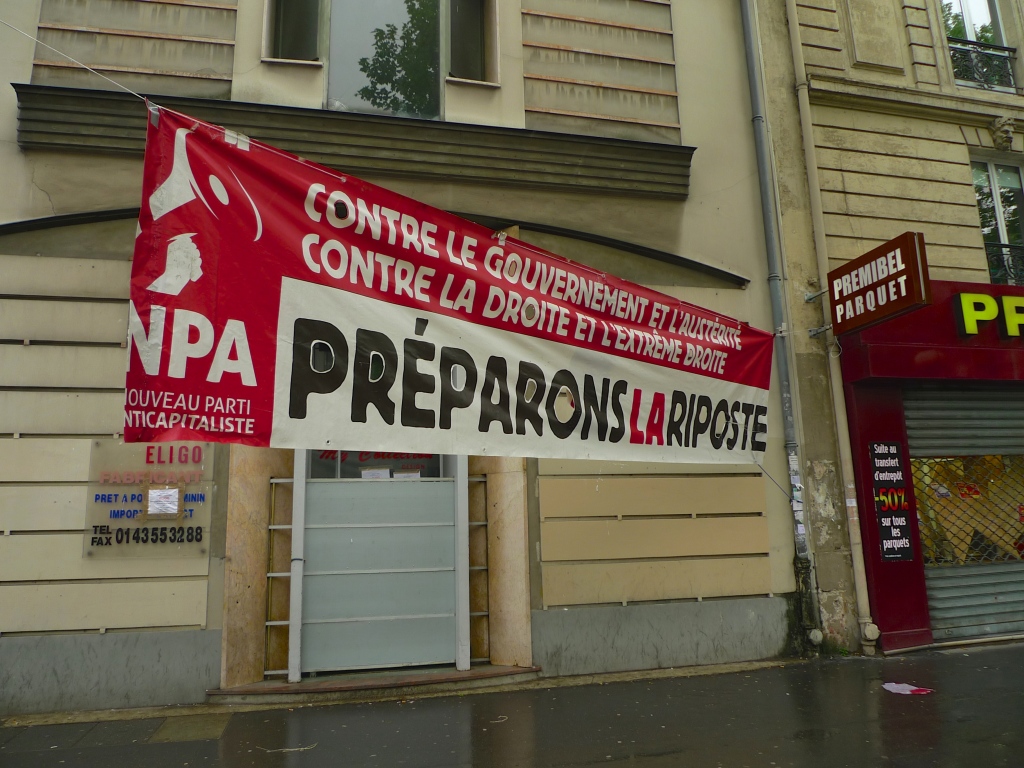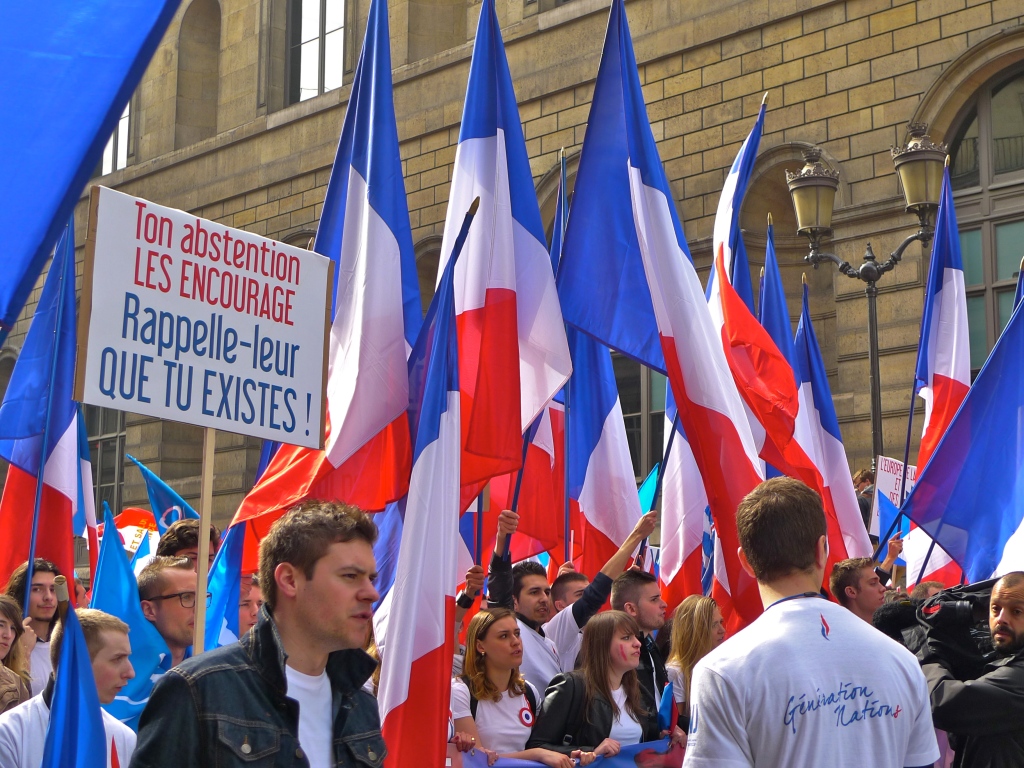La Fête du Travail 2015
IT HAS BECOME a tradition that on the first day of May each year sweet scented sprays of Lily of the Valley (Muguet in French) are sold on the streets across France as a symbol of springtime and good luck.
Amidst the sprays of Lily of the Valley on sale everywhere in Paris yesterday another tradition was playing out.
La Fête du Travail was the name given to several festivals that originated from the eighteenth century onwards to celebrate the achievements of workers. In France, la Fête du Travail merged with International Workers’ Day, a day originally established in the late nineteenth century as an annual day of protest to demand the eight-hour working day. Today, La Fête du Travail and International Workers Day are celebrated on May 1st and the day is a national public holiday.
In Paris it has become traditional for people representing the two extremes of the political spectrum to use the May 1st public holiday to take to the streets to make their voices heard.
On the morning of May 1st, the Front National representing the political far right hold their annual défilé from the Palais Royal to Place de l’Opéra pausing in Place des Pyramides to pay homage at the foot of Emmanuel Frémiet’s gilded statue of Jeanne d’Arc, the Maid of Orléans and heroine to the far right. In the afternoon an assorted collection of organisations representing the far left gather in Place de la République and march along the Boulevard Voltaire to Place de la Nation.
For the past three years I’ve recorded the Front National event on May 1st rather than the event at République because, given the rise of Marine le Pen as Président of the Front National and the party’s increasing popularity with the French electorate, it seemed to me that this was likely to be the more newsworthy event.
This year though I decided it was time to redress the balance and forsake the Front National in favour of the far left manifestation on the other side of the city.
The manifestation beginning in Place de la République was jointly organised by the French Trades Unions, CGT (Confédération générale du travail), FSU (Fédération syndicale unitaire), Solidaires (Solidaires Unitaires Démocratiques) and l’Unsa (Union nationale des syndicats autonomes).
From the plethora of literature handed out along the route I was able to deduce that there were two main themes to the manifestation:
First, in the wake of the Charlie Hebdo attacks on January 11th this year, democracy, peace and freedom of thought and expression are common goods that must be defended against all forms of totalitarianism, hate speeches, stigma and attempts to divide.
And second, against a background of austerity measures and reforms reducing workers’ rights and social protection in many European countries, these policies must be reversed and investment made in quality jobs and growth.
Sounds of le défilé de la Fête du Travail :
After many years of recording sounds in Paris I like to think that I’ve developed a journalist’s nose for a good story, or at the very least for being in the right place at the right time. But this year I’m afraid I got it wrong, the little spray of Lily of the Valley in my pocket failed to bring me good luck.
While standing in the rain for three hours recording this manifestation passing me in Boulevard Voltaire I was completely unaware that the news story of the day had already taken place elsewhere, at the Front National défilé at Place de l’Opéra!
During Marine le Pen’s speech there earlier in the day three bare-breasted women appeared on the balcony of a nearby hotel. The women from the Femen activist group unfurled banners linking the Front National’s logo with the Nazi party and had “Heil Le Pen” and “Stop Fascism” written across their chests. For five minutes, they drowned out Le Pen’s speech using a bullhorn.
I was particularly disappointed when I discovered what had happened, not because I have any affection for Marine le Pen and the Front National or that I’d missed seeing the topless women, in fact I’d seen them before when I was recording the International Women’s Day march in Paris a few weeks ago. No, my disappointment came from the realisation that I’d completely missed capturing an historic sound event that would have been a priceless addition to my Paris Soundscapes Archive.
I am reminded of the great American poet, Maya Angelou, who in her autobiography, I Know Why the Caged Bird Sings, said: “There is no greater agony than bearing an untold story inside you.”
I’m afraid that the sounds of the disruption at yesterday’s Front National rally are and are destined to remain my untold story.
La Fête du Travail – The Marching Season Begins
THE FIRST OF MAY is a public holiday in France, La Fête du Travail or Labour Day as it’s known in some countries.
Traditionally, the First of May is also the day when Lily of the Valley, or Muguet, is sold everywhere on streets across France as a of the symbol of springtime and of good luck.
Muguet (Lily of the Valley) being distributed in rue de Rivoli
La Fête du Travail is primarily an opportunity to campaign for and to celebrate workers’ rights and in Paris many people take to the streets to make their voices heard.
For me, as a sonic journalist and dedicated collector of the sounds of Paris, the First of May always marks the start of the Parisian marching season. I know that over the next few months I will spend many hours on the streets capturing the sounds of marches, demonstrations and protests covering every shade of political opinion.
In Paris it’s become traditional for the two extremes of political opinion to take to the streets on the First of May. In the morning the right-wing Front National march from the Palais-Royal to Place de l’Opéra and in the afternoon the left-wing Socialists and Trades Unions march from Place de la Bastille to Place de la Nation. I used to record both of these marches each year but latterly I’ve taken to recording them alternately, the left one year and the right the next.
This year it was the turn of the Front National and so an hour before the march was due to begin I arrived in the Place des Pyramides in front of Emmanuel Frémiet’s gilded statue of Jeanne d’Arc, heroine to the far right, and jostled with the seasoned TV and Radio crews and the press photographers to get the best vantage point.
I recorded the march as it approached along the rue de Rivoli and then passed the statue of Jeanne d’Arc and then I followed it to the Place de l’Opéra.
Front National March:
Two things struck me about this year’s march. First, the last time I recorded this Front National march was in 2012 and my impression was that there were more marchers then than there were this year. I have no statistical evidence to base that on but it was just my impression. And second, although this year’s marchers were vociferous, they seemed to me to be a little more subdued than in 2012.
If, like me, you are a seasoned observer of Parisian political marches and demonstrations from whatever part of the political spectrum, you cannot fail to be impressed by the importance that sound plays. I believe that the rhythm and constant repetition of the chants not only gives everyone a voice but it also acts as a means of discipline.
As an outside observer on the street, you can see that the rhythm and repetition of the chanting has an almost hypnotic effect on the marchers – although I doubt that they would probably accept that. In any of these political marches there are leaders who dictate what the chant should be, the pace and the rhythm of the chant and how many times it should be repeated and then there are the followers who do exactly that, follow the leader’s command.
It seems to me that through this constant chanting the marchers not only have a voice but they feel that their voice is being heard.
I am convinced that the power of sound through rhythm and constant repetition is the main reason why marches like this seldom become unruly or descend into mindless violence.
I followed the march to Place de l’Opéra but, unlike in 2012, I didn’t stay to record the speeches. Instead I had a fascinating chat with a French radio reporter who gave me a guided tour of her Nagra ARES C sound recorder before she went off to file her report for the lunchtime news bulletin.





















